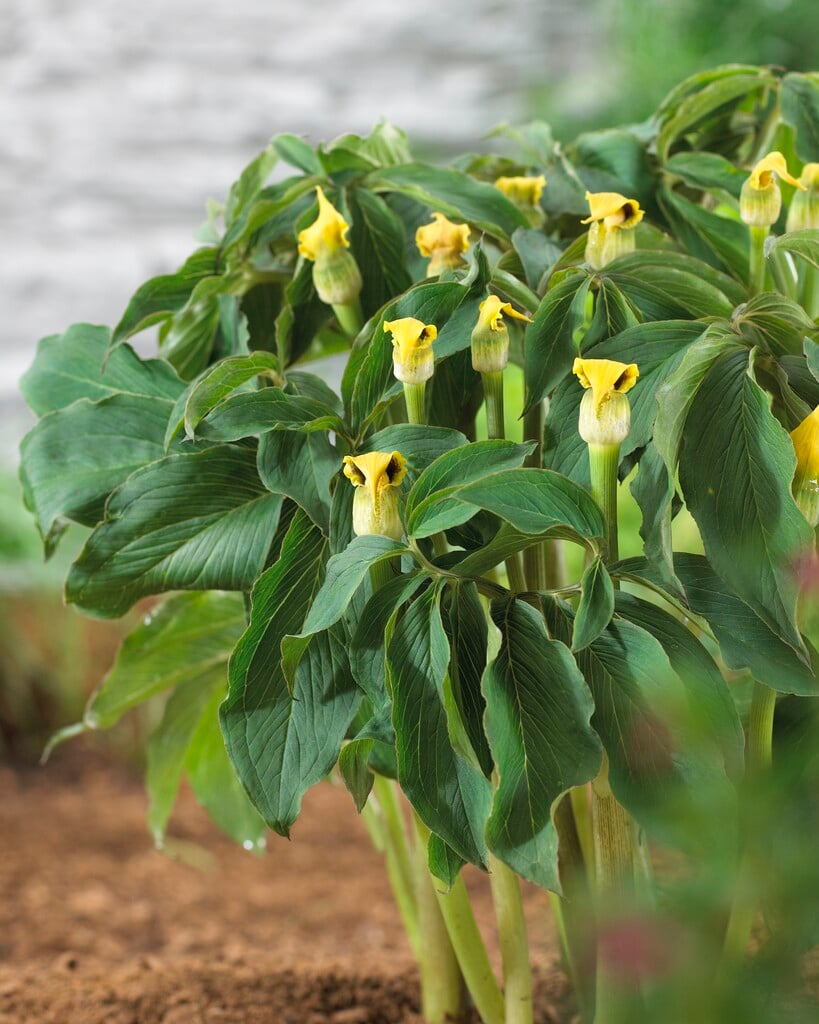Arisaema flavum
yellow cobra lily
A tuberous perennial, to about 40cm. Leaves and flowers both emerge in early summer. Leaves are lobed and dark green. Flowers consist of a bright yellow hooded spathe which has a dark purple blotch inside, surrounding a bright yellow spadix. Flowers throughout June and July
Size
Ultimate height
0.1–0.5 metresTime to ultimate height
5–10 yearsUltimate spread
0.1–0.5 metresGrowing conditions
Moisture
Moist but well–drainedpH
Acid, NeutralColour & scent
| Stem | Flower | Foliage | Fruit | |
| Spring | ||||
|---|---|---|---|---|
| Summer | Yellow Purple | Green | ||
| Autumn | Green | |||
| Winter |
Position
- Partial shade
Aspect
East–facing or North–facing or West–facing
Exposure
Sheltered Hardiness
H6Botanical details
- Family
- Araceae
- Native to GB / Ireland
- No
- Foliage
- Deciduous
- Habit
- Columnar upright
- Potentially harmful
- Humans/Pets: Harmful if eaten, skin/eye irritant. Wear gloves and other protective equipment when handling For further information and contact numbers regarding pets, see the HTA guide to potentially harmful plants
- Genus
Arisaema are mostly tuberous perennials usually with palmately lobed leaves, and distinctive tubular, hooded spathes within which the tiny true flowers are clustered at the base of the club-like or filamentous spadix, followed by a spike of red berries
- Name status
Correct
- Plant range
- NE Tropical Africa to S China
How to grow
Cultivation
Plant the tubers 20cm deep in winter or spring, into moist but well-drained, humus-rich soil in a cool, partially shaded site. In colder regions it may need winter protection, mulch with well-rotted leaf mould for insulation. Tubers must not dry out while dormant but avoid excessive winter wet.
Propagation
Propagate by seed sown in containers in a cold frame in autumn or spring. Offsets may be removed in late summer
Suggested planting locations and garden types
- Cottage and informal garden
- Patio and container plants
- City and courtyard gardens
- Underplanting of roses and shrubs
- Flower borders and beds
Pruning
No pruning required
Pests
May be susceptible to slugs and vine weevil
Diseases
Generally disease-free
Love gardening
Sign up to receive regular gardening tips, inspiration, offers and more
View our Privacy Policy
Get involved
The Royal Horticultural Society is the UK’s leading gardening charity. We aim to enrich everyone’s life through plants, and make the UK a greener and more beautiful place.

